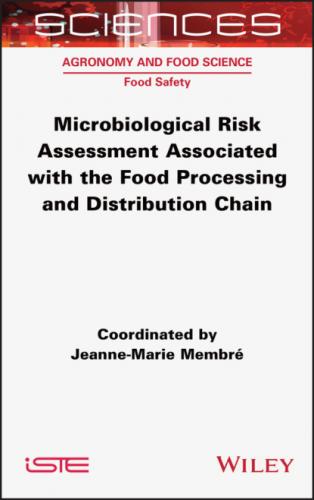Agronomy and Food Science, Field Directors – Jack Legrand and Gilles Trystram
Food Safety, Subject Head – Jeanne-Marie Membré and Thierry Bénézech
Microbiological Risk Assessment Associated with the Food Processing and Distribution Chain
Coordinated by Jeanne-Marie Membré
First published 2022 in Great Britain and the United States by ISTE Ltd and John Wiley & Sons, Inc.
Apart from any fair dealing for the purposes of research or private study, or criticism or review, as permitted under the Copyright, Designs and Patents Act 1988, this publication may only be reproduced, stored or transmitted, in any form or by any means, with the prior permission in writing of the publishers, or in the case of reprographic reproduction in accordance with the terms and licenses issued by the CLA. Enquiries concerning reproduction outside these terms should be sent to the publishers at the undermentioned address:
ISTE Ltd
27-37 St George’s Road
London SW19 4EU
UK
John Wiley & Sons, Inc.
111 River Street
Hoboken, NJ 07030
USA
© ISTE Ltd 2022
The rights of Jeanne-Marie Membré to be identified as the author of this work have been asserted by her in accordance with the Copyright, Designs and Patents Act 1988.
Any opinions, findings, and conclusions or recommendations expressed in this material are those of the author(s), contributor(s) or editor(s) and do not necessarily reflect the views of ISTE Group.
Library of Congress Control Number: 2021952704
British Library Cataloguing-in-Publication Data
A CIP record for this book is available from the British Library
ISBN 978-1-78945-084-2
ERC code:
Applied Life Sciences, Biotechnology, and Molecular and Biosystems Engineering
LS9_5 Food sciences (including food technology, food safety, nutrition)
LS9_8 Biohazards (including biological containment, biosafety, biosecurity)
Preface
Jeanne-Marie MEMBRÉ
SECALIM, INRAE, Oniris, Nantes, France
There are a number of food-associated hazards that can cause harm to human health. Chemicals used in agriculture, environmental pollutants and pathogenic bacteria are all examples of hazards that can ultimately end up on the consumer’s plate and in some cases harm their health.
Food safety standards, the development of which began more than 20 years ago, are used to confront these hazards, with their basis in a formal process called “risk analysis”. Risk analysis consists of three separate elements: risk assessment, risk management and risk communication.
Three volumes on the subject of Food Safety make it possible to articulate this link between food safety and risk analysis. They have been created by Jeanne-Marie Membré and Thierry Bénézech, with the assistance of Nabila Haddad, and published by ISTE Ltd and Wiley in the SCIENCES series:
1 – the volume coordinated by Nabila Haddad covers both chemical and microbiological hazards: Haddad, N. (2022), Hazards in the Food Processing and Distribution Chain;
2 – the volume coordinated by Thierry Bénézech and Christine Faille deals with risk management and focuses on microbiological risks: Bénézech, T. and Faille, C. (2022), Control: Preventing the Biological Risks Associated with Food Contamination During Processing/Distribution and Consumer Usage;
3 – this volume, coordinated by Jeanne-Marie Membré, completes the series. It is entitled Microbiological Risk Assessment Associated with the Food Processing and Distribution Chain.
Acknowledgements
Jeanne-Marie MEMBRÉ
SECALIM, INRAE, Oniris, Nantes, France
I would first of all like to thank Gilles Trystram and Jack Legrand, who entrusted the joint coordination of the topic of Food Safety to me, together with Thierry Bénézech, and also the publishers and their support team.
I would next like to thank Thierry Bénézech and Nabila Haddad, who assisted me in preparing the three volumes on this topic. A big thank you, too, to the authors of the various chapters, without whom this work would not have been possible.
Finally, all my thanks to Marie-France Pilet, director of SECALIM, the INRAE research unit within which I work, who allowed me the time needed to bring this coordination/editorial project to successful fruition.
Introduction
Jeanne-Marie MEMBRÉ
SECALIM, INRAE, Oniris, Nantes, France
Food safety is the guarantee that food is harmless, in other words that its consumption will have no adverse consequences for health. As we are reminded by the World Health Organization (WHO), food safety encompasses all the measures taken to provide food that is as safe as possible, and hence the policies and measures applied must relate to the entire food chain, from production to consumption.
Ensuring a safe food supply poses major food safety challenges for public authorities (FAO and WHO 2006). Changing global patterns of food production, international trade, the emergence of new technologies, public expectations in terms of health protection and many other factors have created an increasingly demanding environment in which food safety must operate (Figure I.1).
There are a number of food-associated risks that can cause harm to human health. Chemicals used in agriculture, environmental pollutants and pathogenic bacteria are all examples of hazards that can ultimately end up on the consumer’s plate and in some cases harm their health.
The first estimates of the global and regional burden of foodborne diseases, published by the WHO in December 2015 (WHO 2015), show that this burden is significant all over the world. Every year around the world, 1 in 10 people fall ill from eating contaminated food and 420,000 die from it, nearly a third of whom are children under the age of 5. The hazards responsible for these foodborne illnesses include bacteria, viruses, parasites, toxins and chemicals. More specifically, diarrheal diseases are responsible for 550 million cases and 230,000 deaths per year. Children are particularly susceptible, with 220 million cases and 96,000 deaths per year. Diarrhea is often caused by eating raw or undercooked meat, eggs, fresh produce and/or dairy produce.
